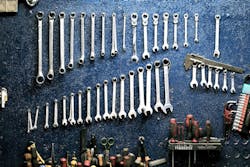People don’t care about what you do; they care about what problem you solve.
Ryan Foland, founder of InfluenceTree, and a master communicator, says it might be a harsh reality for some to think that people don’t care about what you do. But, ultimately, people are largely self-centered, he says.
In order to lay the groundwork for a cohesive brand, Foland feels it begins with each shop operator’s personal narrative. He says that owners might not think they have a personal brand but, in reality, they’re simply not participating in its narrative.
At the end of the day, Foland encourages business owners to put themselves first in the narrative and mix in the personal with the business message.
Foland is also the creator of the 3-1-3 Theory, which, in an effort to convey a clear message, condenses a message from three sentences into one, and then narrows it further—into just three words.
Below, Foland shares his advice on how shop operators can get to a place that meshes what they want to be known for and what people already know about their brand.
As told to Melissa Steinken
“Put yourself first.”
We encourage putting your personal self into the business. Show the customers what goes on behind the scenes. Do you do charity work? Do you own pets? Do you have children in the local schools? To begin starting a cohesive brand, you need to begin by making the name of the brand personal. There have been many body shops to go out of business over the years and when the business goes out or the name of the collision repair shop changes, then the owner loses the brand equity.
“Add a story that makes you more human.”
The next step would be to find a story from your life experience and share it with customers. This has to be a story, however, that makes you look more approachable and human.
For example, it could be as simple as adding a story about how one time you were too tired or lazy to accomplish a goal. This mixes the business with the personal. If you remain stoic and all-business, there is less of a chance that customers will want to do business with you.
Look at your collision repair shop as a people shop. If your car is broken, then you are broken.
“Talk to the person.”
During the on-boarding of a new client, you can make mistakes that can be detrimental to your brand. Don’t talk to the cerebral cortex part of his or her brain, inundating them with numbers and mechanics.
Make that first interaction a personal one. Ask the customer, “Talk to me about your driving style,” or, “How often do you use the car?” These questions can validate the customer’s feelings.
“Add your own story to the website’s bio.”
Telling stories helps to expand memorable moments in your life. You can add the years you’ve been in business and your credentials but that will look like every other shop website bio out there.
You need to add in a story that shares the memorable moments of the start of the business. Think about why you got into the business and any challenges you overcame on the way to where it is today.
If you’re having trouble brainstorming a memory, have another person interview you. Have someone else ask you the deep questions that tell about your childhood, your parents and school. What was something great and what was a tragic moment? Dig into your past, record it and then include it on the website.
Remember to tease out stories that have an emotional connection and include love, loss, insight or inspiration.
“Say your brand in three sentences.”
The concept behind this method is to be able to concisely share with someone else what your brand is. You should be able to say what your brand is in three words.
In the first three sentences, you need to determine the problem that you solve, your solution to that problem and your target audience. If you were to start approaching your business brand as not something that you do but a problem that you solve, people will be more intrigued.
Say you’re talking to a friend of a friend and they ask what you do. You say, “It’s funny because it’s not what I do that’s important but the problem I solved.” Then ask if they think not having a car for a period of time is a problem. Can they get to work? Do they have more than one car in the household? If not having a car is a problem, you can tell them that this is something you fix. Then go into details about how you fix cars if they get into an accident.
Essentially for the three sentences, it is, for these people, for this problem, here is what I do. By combining the three sentences, you can narrow your brand into one sentence.
“Say your brand in three words.”
Now, use a metaphor or analogy to connect two different ideas. You want your brand to be distinguishable and easily memorable for customers. Literally, in a flash of a second, you want people to associate a word with your brand. For instance, if you said, “Golden Arches,” you would think McDonald’s.
Some examples for the auto industry include the Superman of brakes, or the In-N-Out for Toyota vehicles. If you pride yourself on delivering fast work, then you can say that you’re the Flash of collision repair.
“The brand is not a tagline, but building trust.”
At the end of the day, you want the customer to feel that they can trust you and your brand. Your brand is not just a tagline on a website or painted on the side of a car. No, it’s the trust you build with your audience and the personal connections you make with them.




